A Spatial Decision Support System Framework for the Evaluation of Biomass Energy Production Locations: Case Study in the Regional Unit of Drama, Greece
Abstract
1. Introduction
2. Literature Review
2.1. Renewable Energy Sources
2.2. Biomass Energy Production
- Its contribution to poverty reduction in developing countries
- Its ability to constantly meet energy demand
- Its capability on delivering energy in all forms people need (liquid, gas, heat and electricity)
- Its carbon dioxide neutrality
- It helps on the restoration of unproductive and degraded lands, increases biodiversity, soil fertility and water retention
- Inexpensive resources
- Locally distributed
- Price stability
- Generation of employment opportunities
- Biomass export opportunities
- Potentially inexhaustible fuel resource
2.3. MCDA and AHP
3. Methodology
3.1. Criteria Selection
3.2. Human and Environmental Considerations
Constraint Areas Fuzzy Datasets
3.3. Techno-Economic Criteria
- Point sources of biomass
- Arable crops
- Greenhouse crops
- Tree crops
- Vineyards
- Forests
3.4. AHP
- Determination of the goal, the alternatives involved in reaching this goal and the criteria affecting the alternatives.
- Definition of the priorities among the alternatives by performing pairwise comparisons (Table 2).
- Synthetization of the priorities to yield a set of overall priorities for the hierarchy.
- Consistency check.
- Final decision.
4. Results
4.1. Constraint Layer
4.2. Biomass Potential
4.3. Access to Transportation Network and Energy Grid
4.4. Distances from Farms
4.5. Determining Suitable Land
4.6. Results Validation
5. Discussion
6. Conclusions
Author Contributions
Conflicts of Interest
References
- Pasten, C.; Santamarina, J.C. Energy and quality of life. Energy Policy 2012, 49, 468–476. [Google Scholar] [CrossRef]
- Lambert, J.G.; Hall, C.A.S.; Balogh, S.; Gupta, A.; Arnold, M. Energy, EROI and quality of life. Energy Policy 2014, 64, 153–167. [Google Scholar] [CrossRef]
- Mazur, A. Does increasing energy or electricity consumption improve quality of life in industrial nations? Energy Policy 2011, 39, 2568–2572. [Google Scholar] [CrossRef]
- Arto, I.; Capellán-Pérez, I.; Lago, R.; Bueno, G.; Bermejo, R. The energy requirements of a developed world. Energy Sustain. Dev. 2016, 33, 1–13. [Google Scholar] [CrossRef]
- Andreoni, V. Energy Metabolism of 28 World Countries: A Multi-scale Integrated Analysis. Ecol. Econ. 2017, 142, 56–69. [Google Scholar] [CrossRef]
- International Energy Outlook, IEO 2017. U.S. Energy Information Administration, September 2017. Available online: https://www.eia.gov/outlooks/ieo/pdf/0484(2017).pdf (accessed on 10 January 2018).
- Matsumoto, S. How do household characteristics affect appliance usage? Application of conditional demand analysis to Japanese household data. Energy Policy 2016, 94, 214–223. [Google Scholar] [CrossRef]
- Webb, A.; Mayers, K.; France, C.; Koomey, J. Estimating the energy use of high definition games consoles. Energy Policy 2013, 61, 1412–1421. [Google Scholar] [CrossRef]
- Richardson, I.; Thomson, M.; Infield, D. A high-resolution domestic building occupancy model for energy demand simulations. Energy Build. 2008, 40, 1560–1566. [Google Scholar] [CrossRef]
- Viggers, H.; Keall, M.; Wickens, K.; Howden-Chapman, P. Increased house size can cancel out the effect of improved insulation on overall heating energy requirements. Energy Policy 2017, 107, 248–257. [Google Scholar] [CrossRef]
- Stephan, A.; Crawford, R.H. The relationship between house size and life cycle energy demand: Implications for energy efficiency regulations for buildings. Energy 2016, 116, e221. [Google Scholar] [CrossRef]
- Cartalis, C.; Synodinou, A.; Proedrou, M.; Tsangrassoulis, A.; Santamouris, M. Modifications in energy demand in urban areas as a result of climate changes: An assessment for the southeast Mediterranean region. Energy Convers. Manag. 2001, 42, 1647–1656. [Google Scholar] [CrossRef]
- Isaac, M.; van Vuuren, D.P. Modeling global residential sector energy demand for heating and air conditioning in the context of climate change. Energy Policy 2009, 37, 507–521. [Google Scholar] [CrossRef]
- Sailor, D.J.; Pavlova, A.A. Air conditioning market saturation and long-term response of residential cooling energy demand to climate change. Energy 2003, 28, 941–951. [Google Scholar] [CrossRef]
- Alvarez-Herranz, A.; Balsalobre-Lorente, D.; Shahbaz, M.; Cantos, J.M. Energy innovation and renewable energy consumption in the correction of air pollution levels. Energy Policy 2017, 105, 386–397. [Google Scholar] [CrossRef]
- Zecca, A.; Chiari, L. Fossil-fuel constraints on global warming. Energy Policy 2010, 38, 1–3. [Google Scholar] [CrossRef]
- Hansen, J.; Ruedy, R.; Lacis, A.; Sato, M.; Nazarenko, L.; Tausnev, N.; Tegen, I.; Koch, D. Chapter 4 Climate modeling in the global warming debate. Int. Geophys. 2001, 70, 127–164. [Google Scholar]
- Hoffert, M.I.; Covey, C. Deriving Global Climate Sensitivity from Paleoclimate Reconstructions. Nature 1992, 360, 573–576. [Google Scholar] [CrossRef]
- Intergovernmental Panel on Climate Change. Fourth Assessment Report (AR4), Working Group I, UNEP; Cambridge University Press: New York, NY, USA, 2007. [Google Scholar]
- Seinfeld, J.H.; Pandis, S.N. Atmospheric Chemistry and Physics: From Air Pollution to Climate Change; Wiley: New York, NY, USA, 1963. [Google Scholar]
- Shafiee, S.; Topal, E. When will fossil fuel reserves be diminished? Energy Policy 2009, 37, 181–189. [Google Scholar] [CrossRef]
- Mohr, S.H.; Wang, J.; Ellem, G.; Ward, J.; Giurco, D. Projection of world fossil fuels by country. Fuel 2015, 141, 120–135. [Google Scholar] [CrossRef]
- Sorrell, S.; Speirs, J.; Bentley, R.; Brandt, A.; Miller, R. Global oil depletion: A review of the evidence. Energy Policy 2010, 38, 5290–5295. [Google Scholar] [CrossRef]
- Hellenic Statistical Authority. 2015. Available online: http://www.statistics.gr/en/statistics/-/publication/SPK33/ and http://www.statistics.gr/en/statistics/-/publication/SPG06/ (accessed on 5 December 2017).
- Stram, B.N. Key challenges to expanding renewable energy. Energy Policy 2016, 96, 728–734. [Google Scholar] [CrossRef]
- Malesios, C.; Arabatzis, G. Small hydropower stations in Greece: The local people’s attitudes in a mountainous prefecture. Renew. Sustain. Energy Rev. 2010, 14, 2492–2510. [Google Scholar] [CrossRef]
- World Energy Outlook 2012—Executive Summary—English version. IEA, 2012. pp. 6, 24, 28. Available online: https://www.iea.org/publications/freepublications/publication/weo-2012---executive-summary----english-version.html (accessed on 10 January 2018).
- U.S. Energy Information Administration. Available online: https://www.eia.gov/beta/international/data/browser/#/?pa=000000000000000000000000000001&c=4100000002000020000000000000g0002&ug=4&tl_id=2-A&vs=INTL.29-12-AFRC-QBTU.A&vo=0&v=H&start=2004&end=2015 (accessed on 4 December 2017).
- Eurostat. Share of energy from renewable sources. 2017. Available online: http://appsso.eurostat.ec.europa.eu/nui/show.do?query=BOOKMARK_DS-253950_QID_-7A8FB502_UID_-3F171EB0&layout=TIME,C,X,0;GEO,L,Y,0;UNIT,L,Z,0;INDIC_EN,L,Z,1;INDICATORS,C,Z,2;&zSelection=DS-253950UNIT,PC;DS-253950INDICATORS,OBS_FLAG;DS-253950INDIC_EN,119800;&rankName1=UNIT_1_2_-1_2&rankName2=INDICATORS_1_2_-1_2&rankName3=INDIC-EN_1_2_-1_2&rankName4=TIME_1_0_0_0&rankName5=GEO_1_2_0_1&sortC=ASC_-1_FIRST&rStp=&cStp=&rDCh=&cDCh=&rDM=true&cDM=true&footnes=false&empty=false&wai=false&time_mode=ROLLING&time_most_recent=true&lang=EN&cfo=%23%23%23%2C%23%23%23.%23%23%23 (accessed on 5 December 2017).
- Koundouri, P.; Kountouris, Y.; Remoundou, K. Valuing a wind farm construction: A contingent valuation study in Greece. Energy Policy 2009, 37, 1939–1944. [Google Scholar] [CrossRef]
- Arabatzis, G.; Kyriakopoulos, G.; Tsialis, P. Typology of regional units based on RES plants: The case of Greece. Renew. Sustain. Energy Rev. 2017, 78, 1424–1434. [Google Scholar] [CrossRef]
- Coelho, S.T. Traditional biomass energy: Improving its use and moving to modern energy use. In Renewable Energy: A Global Review of Technologies, Policies and Markets; Earthscan: London, UK; Sterling, VA, USA, 2012; pp. 230–261. ISBN 9781849772341. [Google Scholar]
- Demirbas, A.; Ozturk, T.; Demirbas, M.F. Recovery of energy and chemicals from carbonaceous materials. Energy Sources Part A Recover. Util. Environ. Eff. 2006, 28, 1473–1482. [Google Scholar] [CrossRef]
- Demirbaş, A. Biomass resource facilities and biomass conversion processing for fuels and chemicals. Energy Convers. Manag. 2001, 42, 1357–1378. [Google Scholar] [CrossRef]
- Demirbas, A. Conversion of corn stover to chemicals and fuels. Energy Sources Part A Recover. Util. Environ. Eff. 2008, 30, 788–796. [Google Scholar] [CrossRef]
- Ruiz, J.A.; Juárez, M.C.; Morales, M.P.; Muñoz, P.; Mendívil, M.A. Biomass gasification for electricity generation: Review of current technology barriers. Renew. Sustain. Energy Rev. 2013, 18, 174–183. [Google Scholar] [CrossRef]
- Center for Renewable Energy Sources (CRES). 2017. Available online: http://www.cres.gr/energy-saving/images/pdf/biomass_guide.pdf (accessed on 3 January 2018).
- Ellabban, O.; Abu-Rub, H.; Blaabjerg, F. Renewable energy resources: Current status, future prospects and their enabling technology. Renew. Sustain. Energy Rev. 2014, 39, 748–764. [Google Scholar] [CrossRef]
- Kougkoulos, I.; Cook, S.J.; Jomelli, V.; Clarke, L.; Symeonakis, E.; Dortch, J.M.; Edwards, L.A.; Merad, M. Use of multi-criteria decision analysis to identify potentially dangerous glacial lakes. Sci. Total Environ. 2017. [Google Scholar] [CrossRef] [PubMed]
- Ioannou, K.; Lefakis, P.; Arabatzis, G. Development of a decision support system for the study of an area after the occurrence of forest fire International. J. Sustain. Soc. 2011, 3, 5–32. [Google Scholar]
- Grigoroudis, E.; Petridis, K.; Arabatzis, G. RDEA: A recursive DEA based algorithm for the optimal design of biomass supply chain networks. Renew. Energy 2014, 71, 113–122. [Google Scholar] [CrossRef]
- Arabatzis, G.; Petridis, K.; Galatsidas, S.; Ioannou, K. A demand scenario based fuelwood supply chain: A conceptual model. Renew. Sustain. Energy Rev. 2013, 25, 687–697. [Google Scholar] [CrossRef]
- Kyriakopoulos, G.L.; Arabatzis, G.; Chalikias, M. Renewables exploitation for energy production and biomass use for electricity generation. A multi-parametric literature-based review. AIMS Energy 2016, 4, 762–803. [Google Scholar] [CrossRef]
- Saaty, T.L. Fundamentals of Decision Making and Priority Theory; RWS Publications: Pittsburgh, PA, USA, 2001; ISBN 0-9620317-6-3. [Google Scholar]
- Chaouachi, A.; Covrig, C.F.; Ardelean, M. Multi-criteria selection of offshore wind farms: Case study for the Baltic States. Energy Policy 2017, 103, 179–192. [Google Scholar] [CrossRef]
- Aly, A.; Jensen, S.S.; Pedersen, A.B. Solar power potential of Tanzania: Identifying CSP and PV hot spots through a GIS multicriteria decision making analysis. Renew. Energy 2017, 113, 159–175. [Google Scholar] [CrossRef]
- Kausika, B.B.; Dolla, O.; van Sark, W.G.J.H.M. Assessment of policy based residential solar PV potential using GIS-based multicriteria decision analysis: A case study of Apeldoorn, The Netherlands. Energy Procedia 2017, 134, 110–120. [Google Scholar] [CrossRef]
- Al Garni, H.Z.; Awasthi, A. Solar PV power plant site selection using a GIS-AHP based approach with application in Saudi Arabia. Appl. Energy 2017, 206, 1225–1240. [Google Scholar] [CrossRef]
- Tsoutsos, T.; Tsitoura, I.; Kokologos, D.; Kalaitzakis, K. Sustainable siting process in large wind farms case study in Crete. Renew. Energy 2015, 75, 474–480. [Google Scholar] [CrossRef]
- Latinopoulos, D.; Kechagia, K. A GIS-based multi-criteria evaluation for wind farm site selection. A regional scale application in Greece. Renew. Energy 2015, 78, 550–560. [Google Scholar] [CrossRef]
- Singh, R.P.; Nachtnebel, H.P. Analytical hierarchy process (AHP) application for reinforcement of hydropower strategy in Nepal. Renew. Sustain. Energy Rev. 2016, 55, 43–58. [Google Scholar] [CrossRef]
- Yalcin, M.; Kilic Gul, F. A GIS-based multi criteria decision analysis approach for exploring geothermal resources: Akarcay basin (Afyonkarahisar). Geothermics 2017, 67, 18–28. [Google Scholar] [CrossRef]
- Kiavarz, M.; Jelokhani-Niaraki, M. Geothermal prospectivity mapping using GIS-based Ordered Weighted Averaging approach: A case study in Japan’s Akita and Iwate provinces. Geothermics 2017, 70, 295–304. [Google Scholar] [CrossRef]
- Wang, Y.M.; Chin, K.S. Fuzzy analytic hierarchy process: A logarithmic fuzzy preference programming methodology. Int. J. Approx. Reason. 2011, 52, 541–553. [Google Scholar] [CrossRef]
- Zyoud, S.H.; Kaufmann, L.G.; Shaheen, H.; Samhan, S.; Fuchs-Hanusch, D. A framework for water loss management in developing countries under fuzzy environment: Integration of Fuzzy AHP with Fuzzy TOPSIS. Expert Syst. Appl. 2016, 61, 86–105. [Google Scholar] [CrossRef]
- Asakereh, A.; Soleymani, M.; Sheikhdavoodi, M.J. A GIS-based Fuzzy-AHP method for the evaluation of solar farms locations: Case study in Khuzestan province, Iran. Sol. Energy 2017, 155, 342–353. [Google Scholar] [CrossRef]
- Kaya, T.; Kahraman, C. Multicriteria renewable energy planning using an integrated fuzzy VIKOR & AHP methodology: The case of Istanbul. Energy 2010, 35, 2517–2527. [Google Scholar] [CrossRef]
- Sadeghi, A.; Larimian, T.; Molabashi, A. Evaluation of Renewable Energy Sources for Generating Electricity in Province of Yazd: A Fuzzy Mcdm Approach. Procedia Soc. Behav. Sci. 2012, 62, 1095–1099. [Google Scholar] [CrossRef]
- Şengül, Ü.; Eren, M.; Eslamian Shiraz, S.; Gezder, V.; Sengül, A.B. Fuzzy TOPSIS method for ranking renewable energy supply systems in Turkey. Renew. Energy 2015, 75, 617–625. [Google Scholar] [CrossRef]
- Haddad, B.; Liazid, A.; Ferreira, P. A multi-criteria approach to rank renewables for the Algerian electricity system. Renew. Energy 2017, 107, 462–472. [Google Scholar] [CrossRef]
- Sindhu, S.; Nehra, V.; Luthra, S. Investigation of feasibility study of solar farms deployment using hybrid AHP-TOPSIS analysis: Case study of India. Renew. Sustain. Energy Rev. 2017, 73, 496–511. [Google Scholar] [CrossRef]
- Aragonés-Beltrán, P.; Chaparro-González, F.; Pastor-Ferrando, J.P.; Pla-Rubio, A. An AHP (Analytic Hierarchy Process)/ANP (Analytic Network Process)-based multi-criteria decision approach for the selection of solar-thermal power plant investment projects. Energy 2014, 66, 222–238. [Google Scholar] [CrossRef]
- Tavana, M.; Santos Arteaga, F.J.; Mohammadi, S.; Alimohammadi, M. A fuzzy multi-criteria spatial decision support system for solar farm location planning. Energy Strateg. Rev. 2017, 18, 93–105. [Google Scholar] [CrossRef]
- Tasri, A.; Susilawati, A. Selection among renewable energy alternatives based on a fuzzy analytic hierarchy process in Indonesia. Sustain. Energy Technol. Assess. 2014, 7, 34–44. [Google Scholar] [CrossRef]
- Heo, E.; Kim, J.; Boo, K.-J. Analysis of the assessment factors for renewable energy dissemination program evaluation using fuzzy AHP. Renew. Sustain. Energy Rev. 2010, 14, 2214–2220. [Google Scholar] [CrossRef]
- Toklu, E. Biomass energy potential and utilization in Turkey. Renew. Energy 2017, 107, 235–244. [Google Scholar] [CrossRef]
- Dominguez Bravo, J.; Garcia Casals, X.; Pinedo Pascua, I. GIS approach to the definition of capacity and generation ceilings of renewable energy technologies. Energy Policy 2007, 35, 4879–4892. [Google Scholar] [CrossRef]
- Arnette, A.N.; Zobel, C.W. Spatial analysis of renewable energy potential in the greater southern Appalachian mountains. Renew. Energy 2011, 36, 2785–2798. [Google Scholar] [CrossRef]
- Baban, S.M.J.; Parry, T. Developing and applying a GIS-assisted approach to locating wind farms in the UK. Renew. Energy 2001, 24, 59–71. [Google Scholar] [CrossRef]
- Alabi, O. An investigation on using GIS to prospect for renewable energy in Nigeria. Ph.D. Thesis, University of Missouri-Kansas City, Kansas City, MO, USA, 2010. [Google Scholar]
- Aydin, N.Y.; Kentel, E.; SebnemDuzgun, H. GIS-based site selection methodology for hybrid renewable energy systems: A case study from western Turkey. Energy Convers. Manag. 2013, 70, 90–106. [Google Scholar] [CrossRef]
- Al-Yahyai, S.; Charabi, Y.; Gastli, A.; Al-Badi, A. Wind farm land suitability indexing using multi-criteria analysis. Renew. Energy 2012, 44, 80–87. [Google Scholar] [CrossRef]
- Dunsford, H.; Macfarlane, R.; Turner, K. The Development of a Regional Geographical Information System for the North East Renewable Energy Strategy; Centre for Environmental and Spatial Analysis, University of Northumbria: England, UK, 2003. [Google Scholar]
- Sánchez-Lozano, J.M.; Teruel-Solano, J.; Soto-Elvira, P.L.; Socorro García-Cascales, M. Geographical Information Systems (GIS) and Multi-Criteria Decision Making (MCDM) methods for the evaluation of solar farms locations: Case study in south-eastern Spain. Renew. Sustain. Energy Rev. 2013, 24, 544–556. [Google Scholar] [CrossRef]
- Tsoutsos, T.; Frantzeskaki, N.; Gekas, V. Environmental impacts from the solar energy technologies. Energy Policy 2005, 33, 289–296. [Google Scholar] [CrossRef]
- Brewer, J.; Ames, D.P.; Solan, D.; Lee, R.; Carlisle, J. Using GIS analytics and social preference data to evaluate utility-scale solar power site suitability. Renew. Energy 2015, 81, 825–836. [Google Scholar] [CrossRef]
- Charabi, Y.; Gastli, A. PV site suitability analysis using GIS-based spatial fuzzy multi-criteria evaluation. Renew. Energy 2011, 36, 2554–2561. [Google Scholar] [CrossRef]
- Watson, J.J.W.; Hudson, M.D. Regional Scale wind farm and solar farm suitability assessment using GIS-assisted multi-criteria evaluation. Landsc. Urban Plan. 2015, 138, 20–31. [Google Scholar] [CrossRef]
- Ciolkosz, D.; Jacobson, M.; Heil, N.; Brandau, W. An assessment of farm scale biomass pelleting in the Northeast. Renew. Energy 2017, 108, 85–91. [Google Scholar] [CrossRef]
- Purdy, A.; Pathare, P.B.; Wang, Y.; Roskilly, A.P.; Huang, Y. Towards sustainable farming: Feasibility study into energy recovery from bio-waste on a small-scale dairy farm. J. Clean. Prod. 2018, 174, 899–904. [Google Scholar] [CrossRef]
- Ferreira, S.; Monteiro, E.; Brito, P.; Vilarinho, C. Biomass resources in Portugal: Current status and prospects. Renew. Sustain. Energy Rev. 2017, 78, 1221–1235. [Google Scholar] [CrossRef]
- Villarini, M.; Bocci, E.; Di Carlo, A.; Savuto, E.; Pallozzi, V. The case study of an innovative small scale biomass waste gasification heat and power plant contextualized in a farm. Energy Procedia 2015, 82, 335–342. [Google Scholar] [CrossRef]
- Arabatzis, G.; Myronidis, D. Contribution of SHP Stations to the development of an area and their social acceptance. Renew. Sustain. Energy Rev. 2011, 15, 3909–3917. [Google Scholar] [CrossRef]
- Tampakis, S.; Tsantopoulos, G.; Arabatzis, G.; Rerras, I. Citizens’ views on various forms of energy and their contribution to the environment. Renew. Sustain. Energy Rev. 2013, 20, 473–482. [Google Scholar] [CrossRef]
- Skoulou, V. Design and development of a gasification reactor for energy production from biomass. Ph.D. Thesis, Department of Chemical Engineering, Aristotle University of Thessaloniki, Serres, Greece, 2009. [Google Scholar]
- Malcezewski, J. GIS based lan-use suitability analysis: A critical overview. Prog. Plan. 2004, 62, 3–65. [Google Scholar] [CrossRef]
- Kalavrouziotis, I.; Hortis, T.; Drakatos, P. The reuse of wastewater and sludge for cultivation of forestry trees in desert areas in Greece. Int. J. Environ. Pollut. 2004, 21, 425. [Google Scholar] [CrossRef]
- Torrieri, F.; Bata, A. Spatial Multi-criteria Decision Support System and Strategic Impact Assessment: A case study. Buildings 2017, 7, 96. [Google Scholar] [CrossRef]
- Chakhar, S.; Mousseau, V. Multicriteria Decision Making, Spatial. In Encyclopedia of GIS; Shekhar, S., Xiong, H., Eds.; Springer: Boston, MA, USA, 2008. [Google Scholar]
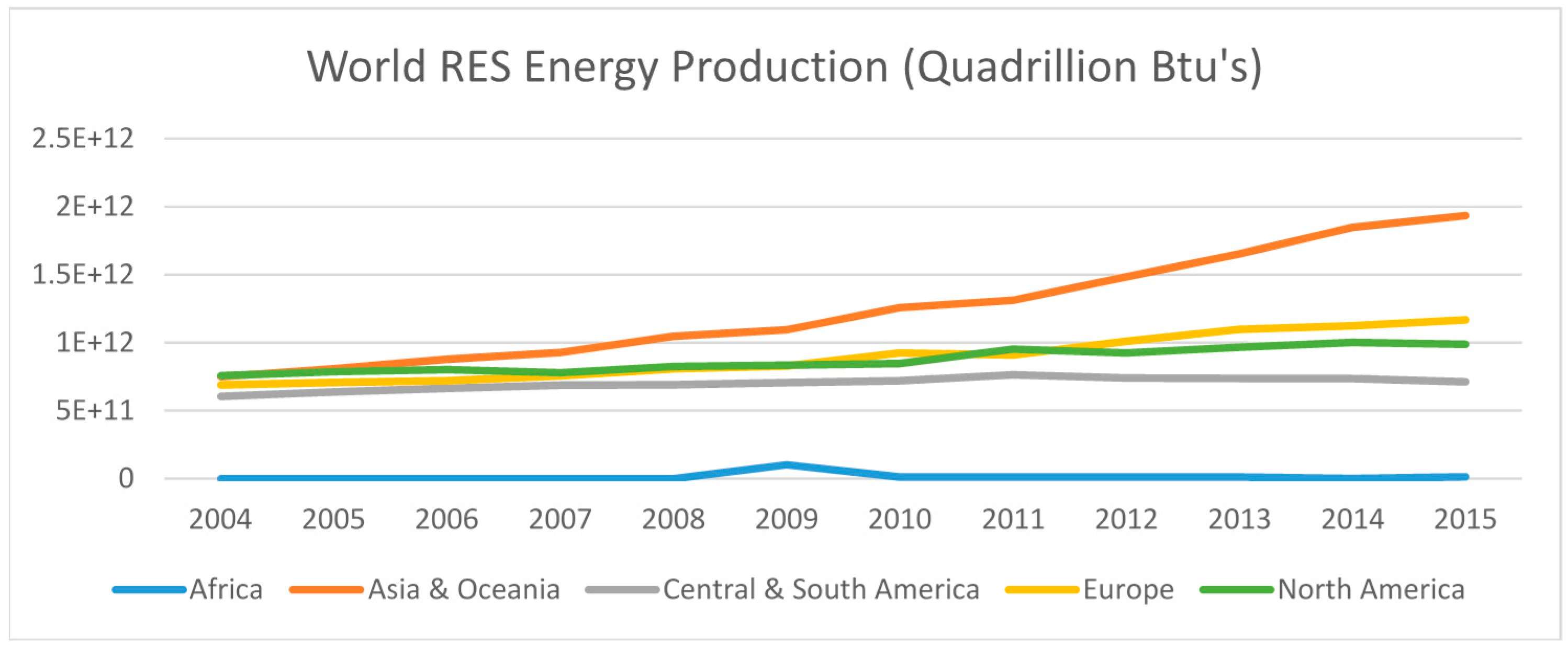
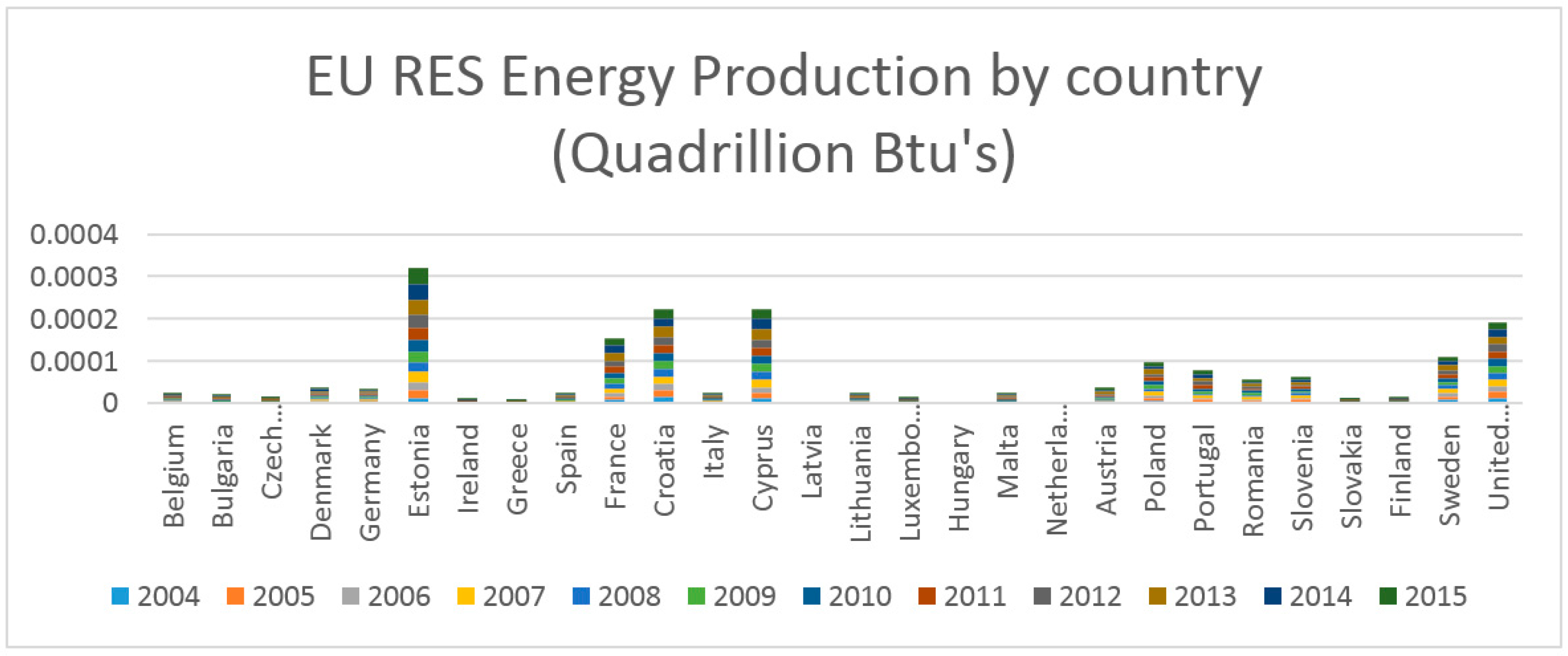
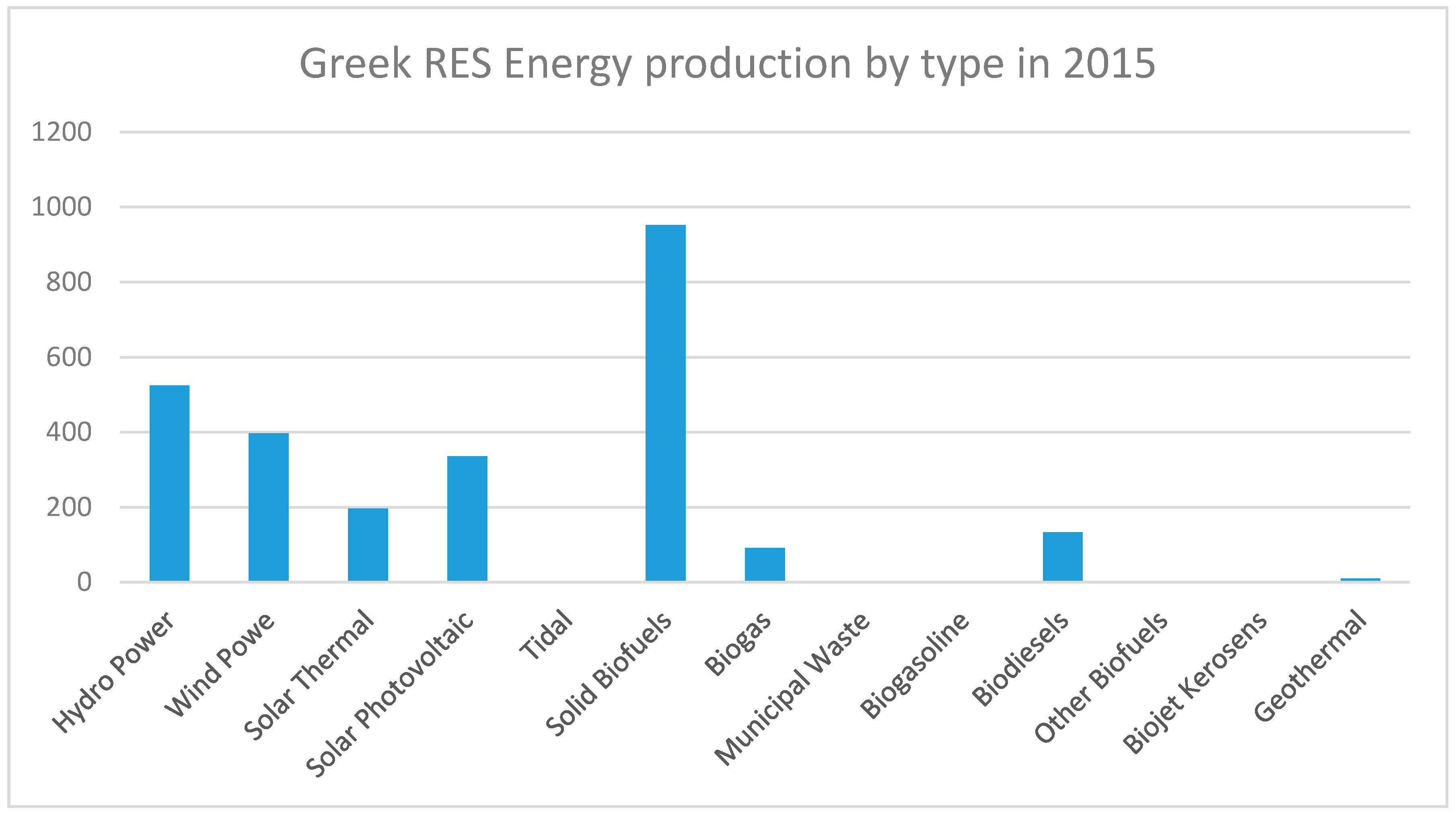
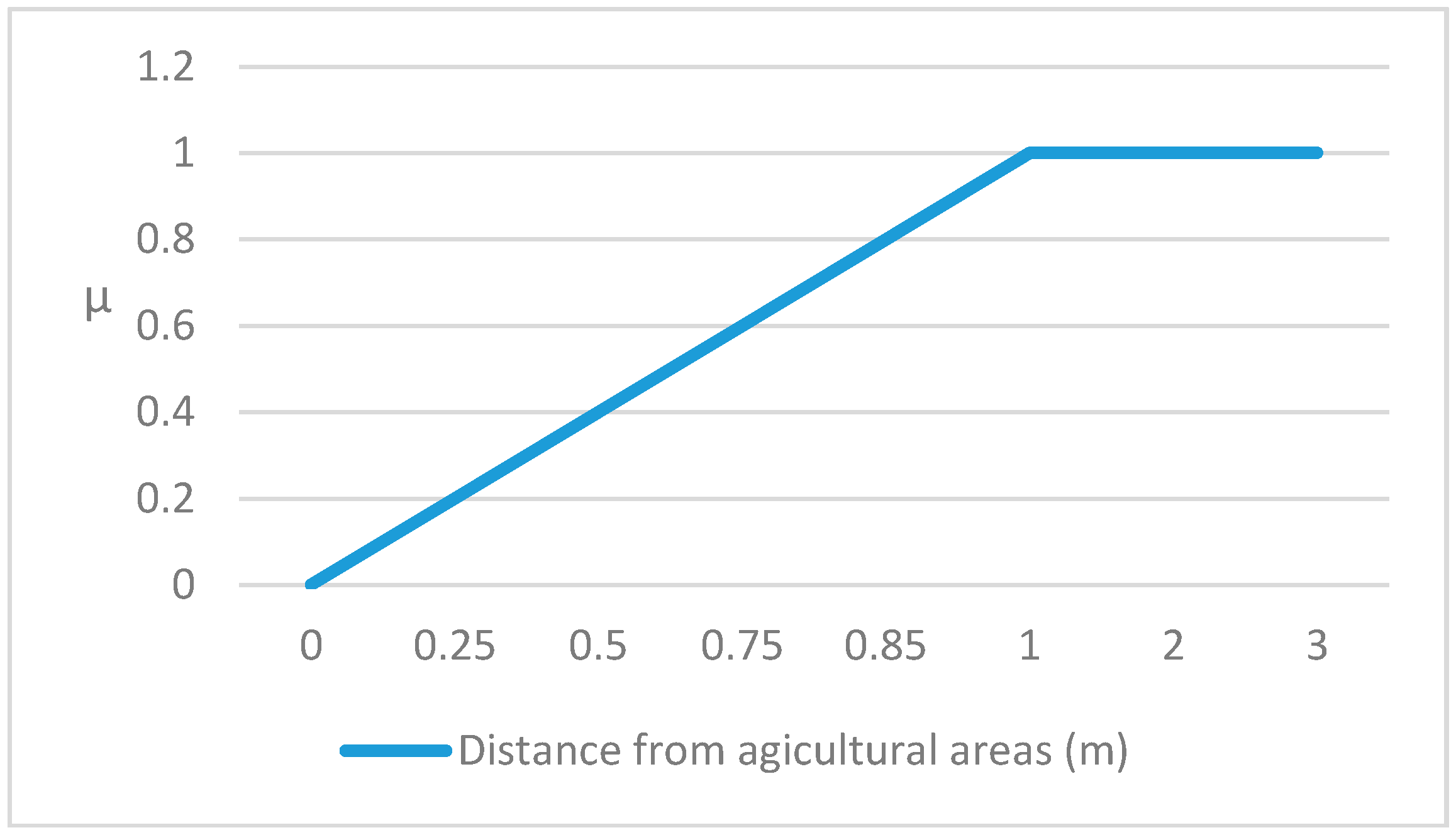
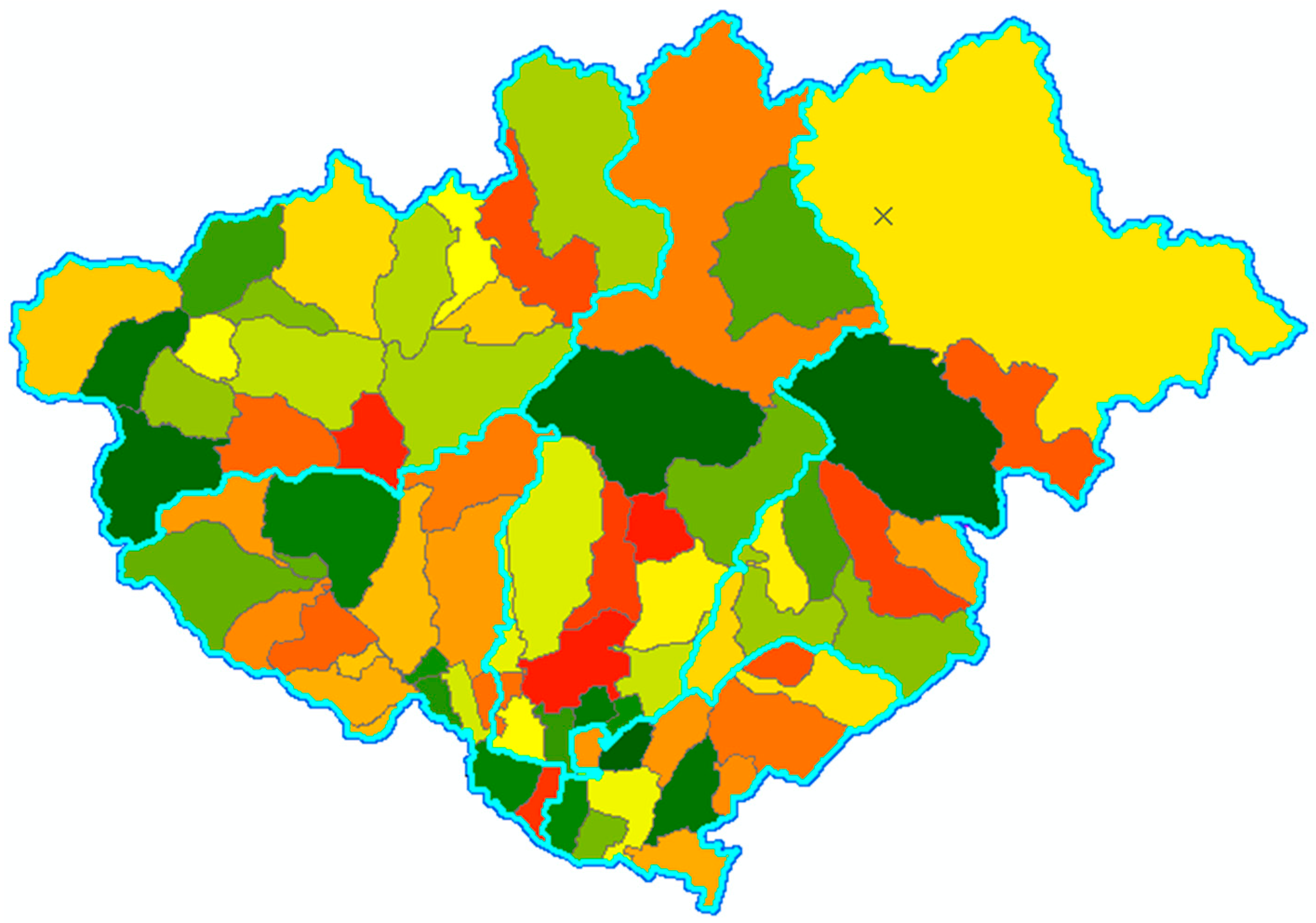
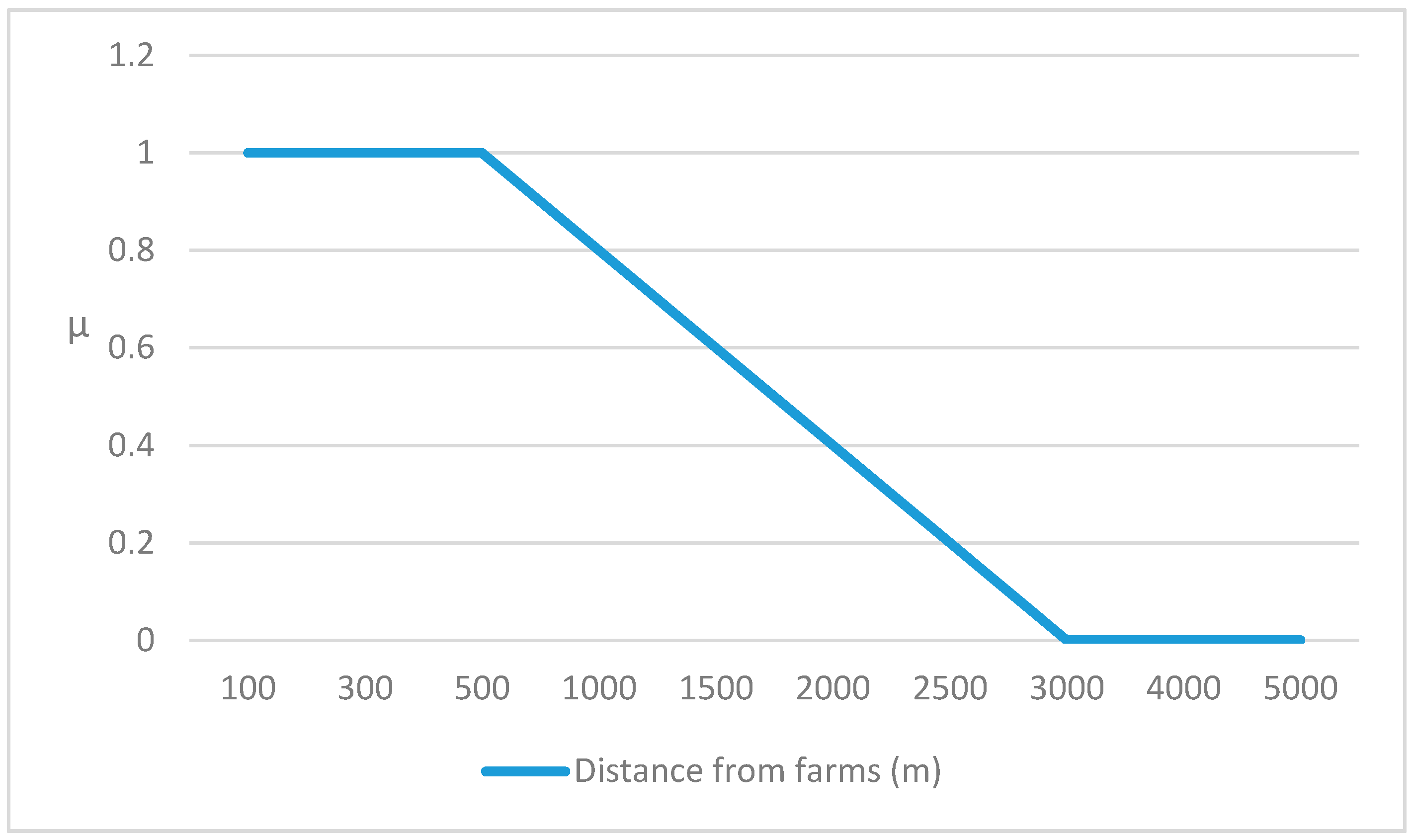
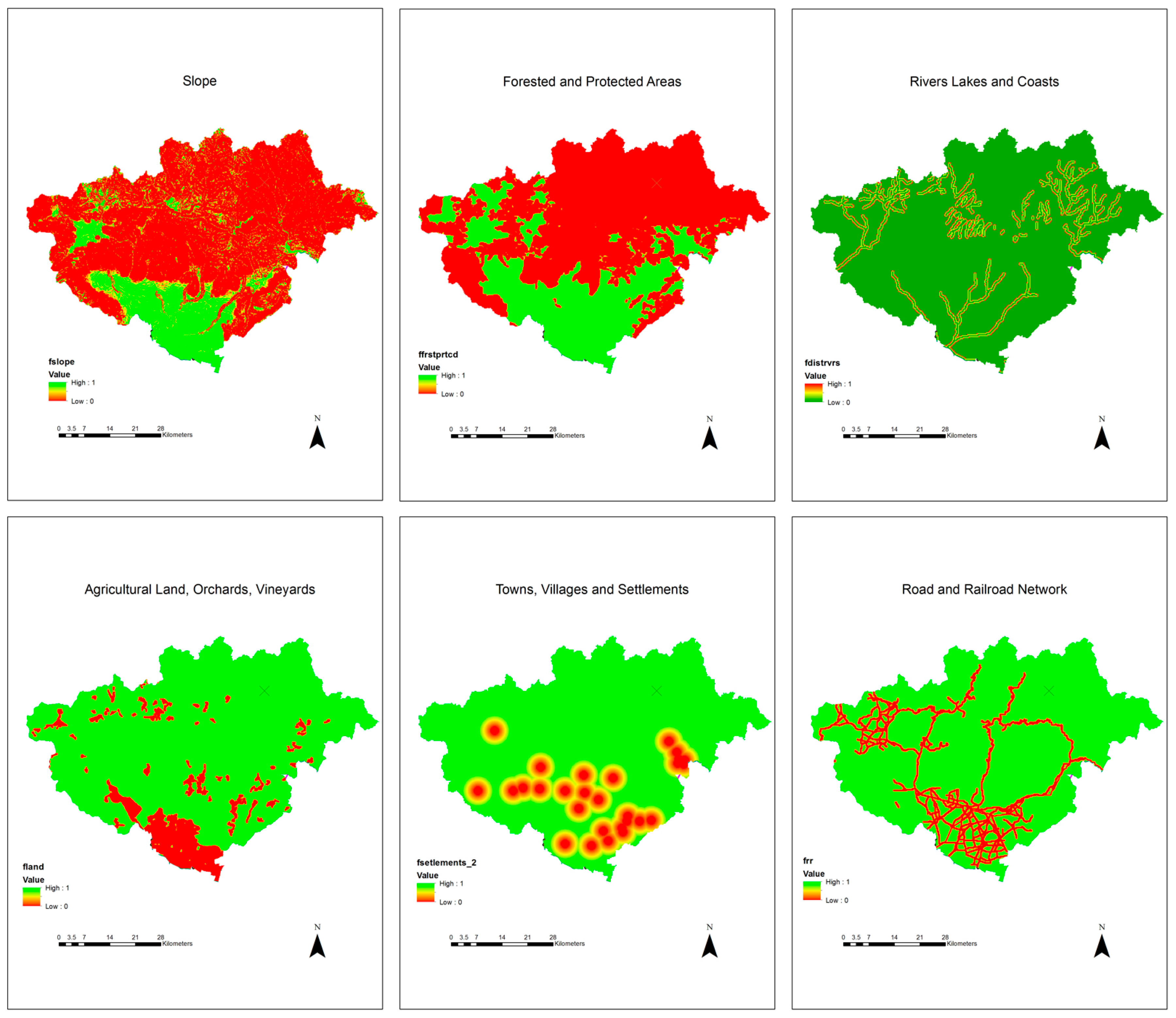
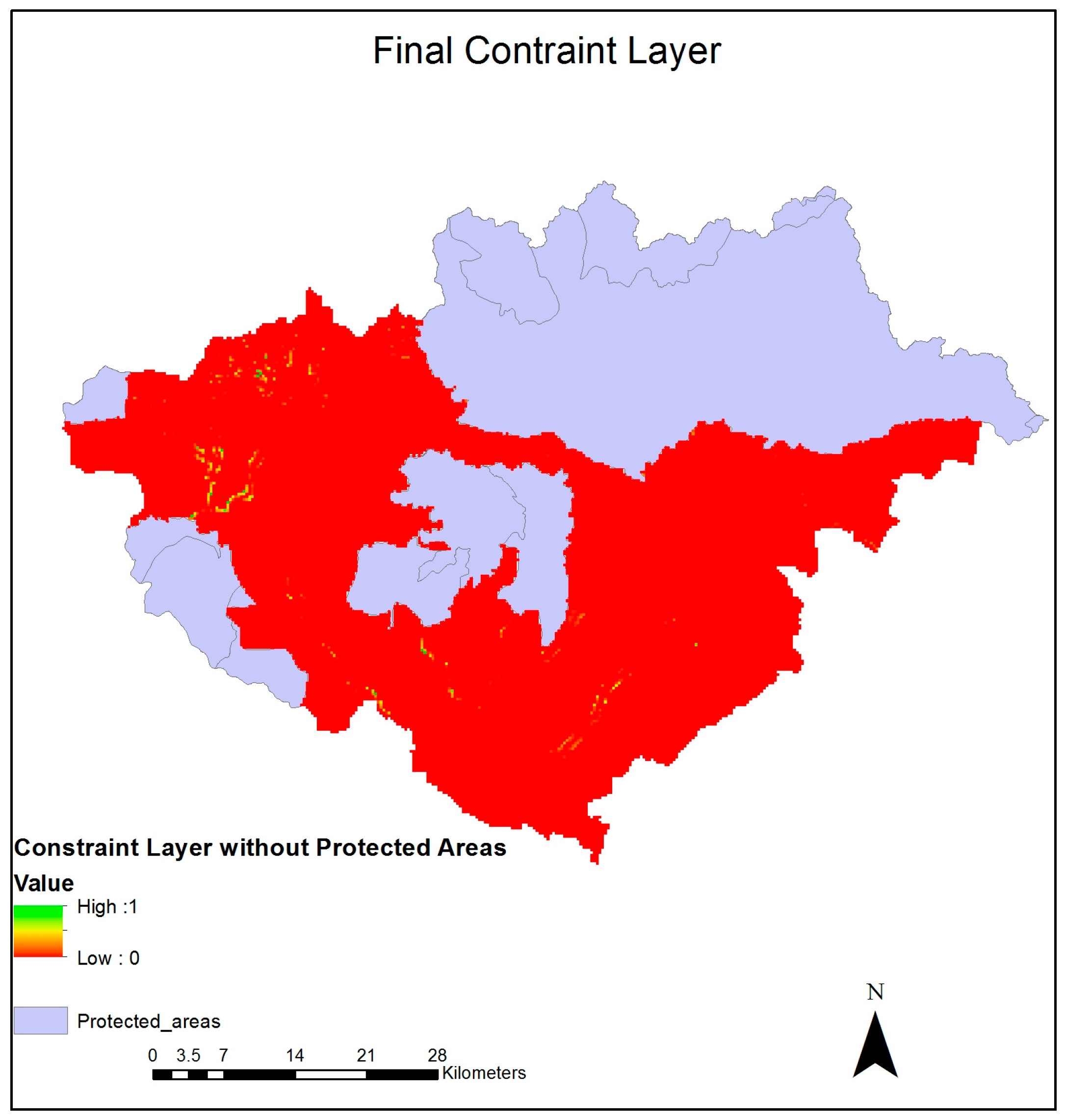
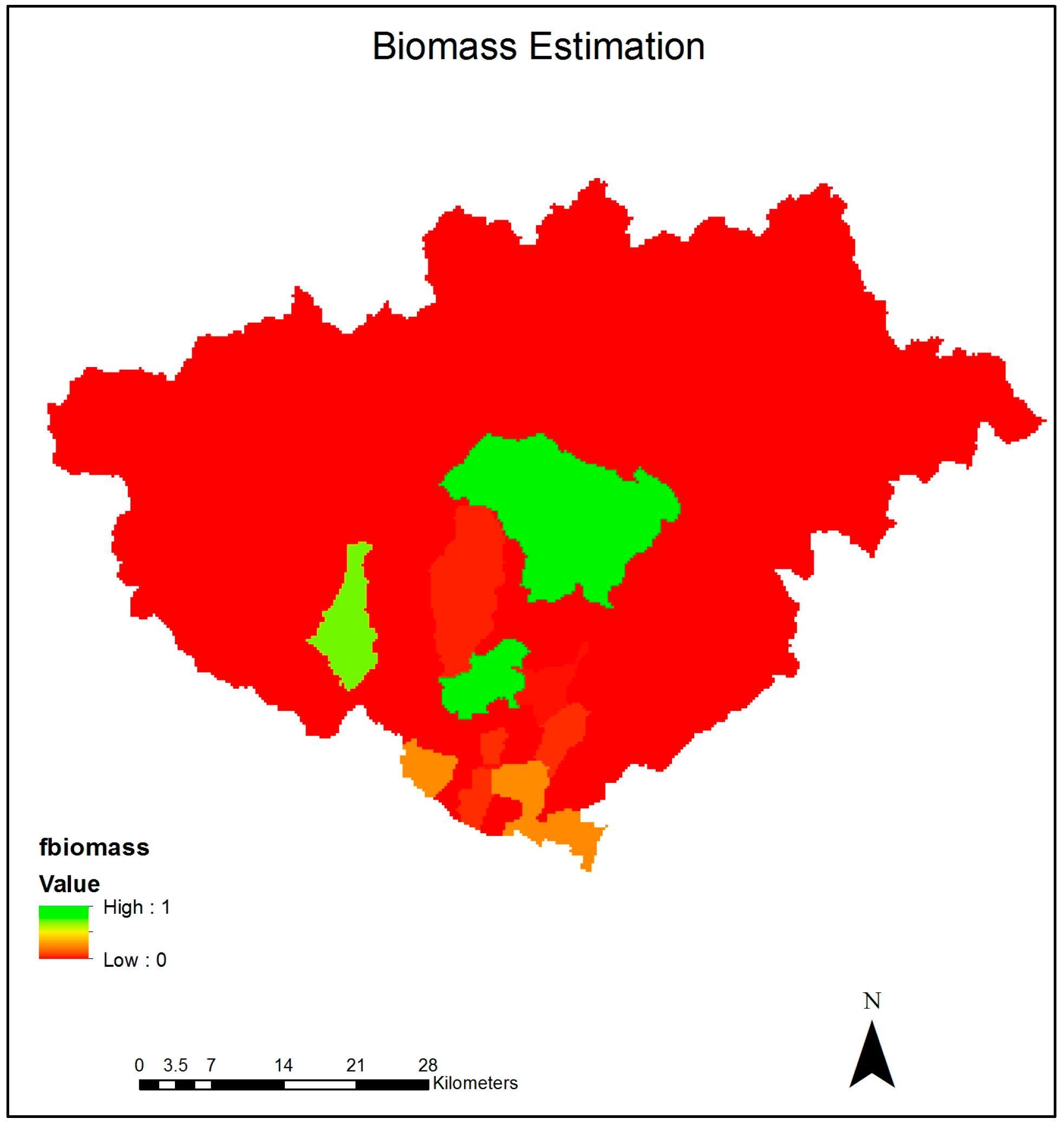
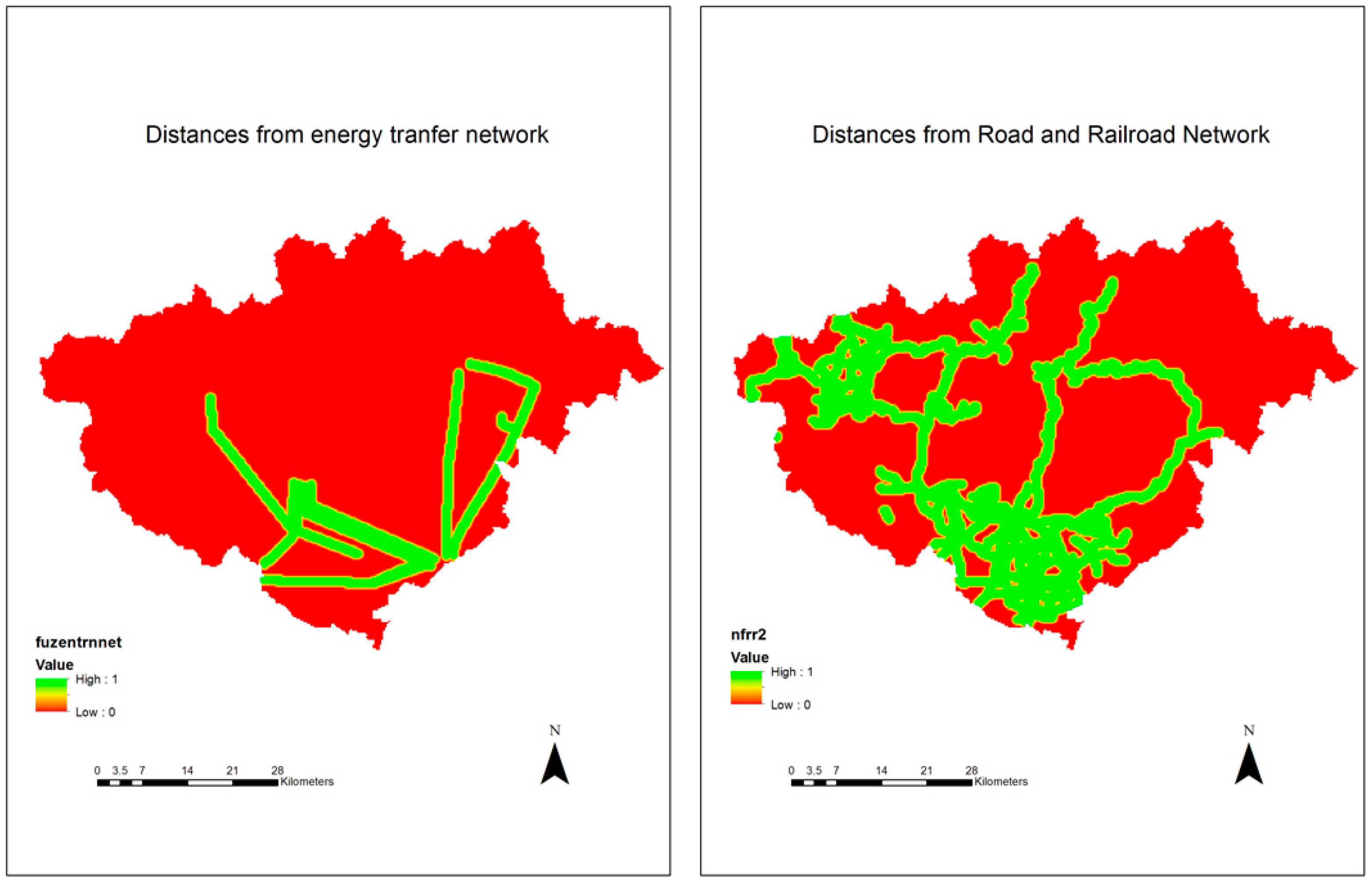
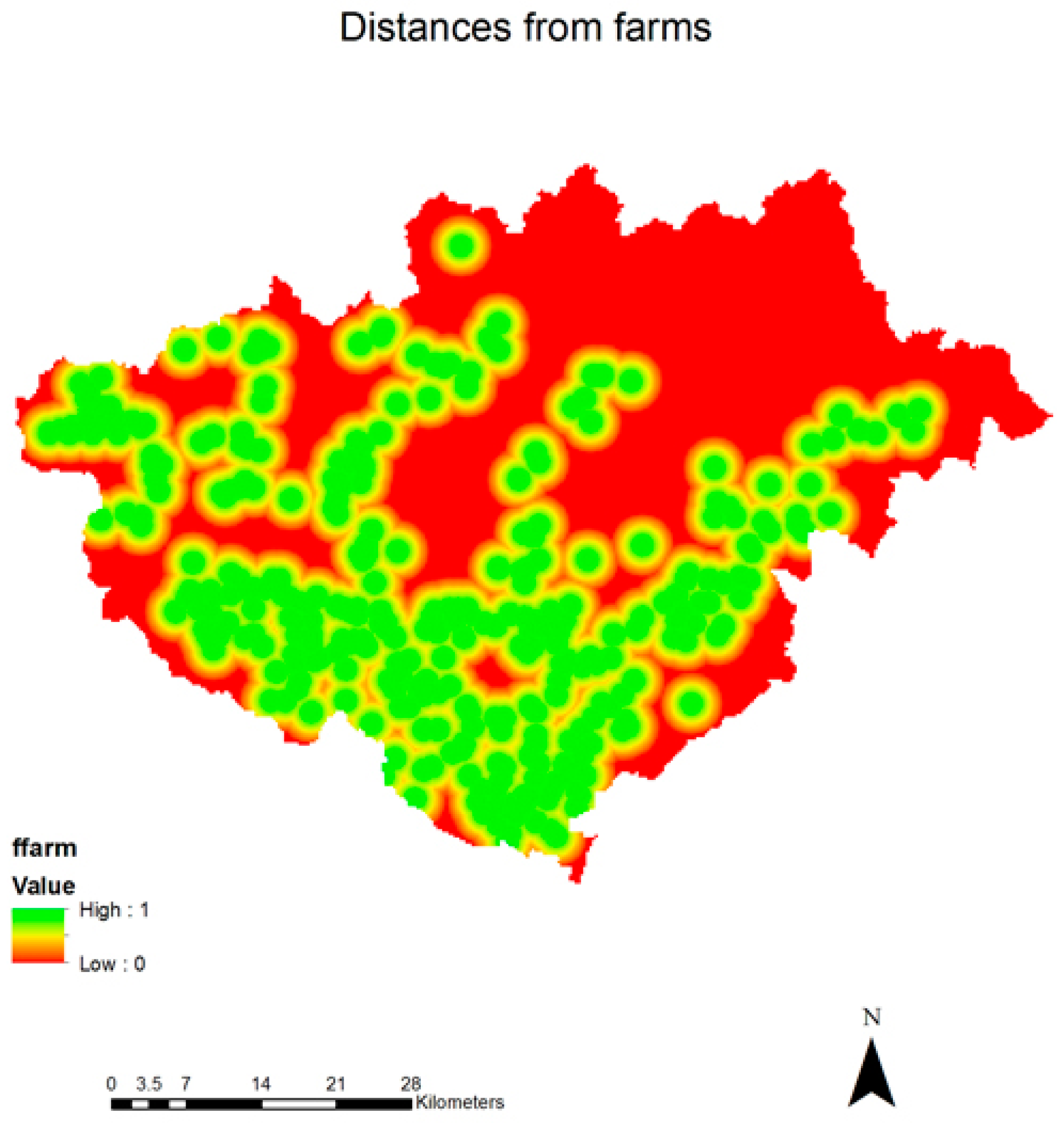

| Criterion | Limitations | References |
|---|---|---|
| Slope | Between 0 and 10% for constructions and accessibility from vehicles | [68] |
| Heavily forested areas and Protected areas | Restriction: these zones are completely off limits | Ν2742/1999 (Greek Legislation) |
| Water Bodies, wetlands, rivers | 500 m buffer zone for wetlands 400 m buffer zone for wetlands 300 m buffer zone for wetlands 500 m buffer zone for rivers 400 m buffer zone for rivers 1000 m from coast 200 m from rivers | [69] [70] [71] [69] [70] Ν2742/1999 (Greek Legislation) |
| Agricultural land, pastures, Orchards | Agricultural land, pastures and orchards are unsuitable | [68,72] |
| Urban areas | 2000 m from urban areas 1–5 km from urban areas | Ν2742/1999 (Greek Legislation), [72] |
| Road and railroad network | 500 m buffer zone 150 m buffer zone railroad area restriction | [73] [74] [75] Ν2742/1999 (Greek Legislation) |
| Definition | Index | Definition | Index |
|---|---|---|---|
| Equally Important | 1 | Equally important | 1/1 |
| Equally or slightly more important | 2 | Equally or slightly less important | 1/2 |
| Slightly more important | 3 | Slightly less important | 1/3 |
| Slightly to much more important | 4 | Slightly-to-way less important | 1/4 |
| Much more important | 5 | Way less important | 1/5 |
| Much-to-far more important | 6 | Way to far less important | 1/6 |
| Far more important | 7 | Far less important | 1/7 |
| Far more important to extremely more important | 8 | Far less important to extremely less important | 1/8 |
| Extremely more important | 9 | Extremely less important | 1/9 |
| Criteria | Weight Coefficient |
|---|---|
| Constraint Layer | 0.458 |
| Transportation network | 0.033 |
| Proximity to farms | 0.142 |
| Energy grid | 0.07 |
| Biomass potential | 0.297 |
© 2018 by the authors. Licensee MDPI, Basel, Switzerland. This article is an open access article distributed under the terms and conditions of the Creative Commons Attribution (CC BY) license (http://creativecommons.org/licenses/by/4.0/).
Share and Cite
Ioannou, K.; Tsantopoulos, G.; Arabatzis, G.; Andreopoulou, Z.; Zafeiriou, E. A Spatial Decision Support System Framework for the Evaluation of Biomass Energy Production Locations: Case Study in the Regional Unit of Drama, Greece. Sustainability 2018, 10, 531. https://doi.org/10.3390/su10020531
Ioannou K, Tsantopoulos G, Arabatzis G, Andreopoulou Z, Zafeiriou E. A Spatial Decision Support System Framework for the Evaluation of Biomass Energy Production Locations: Case Study in the Regional Unit of Drama, Greece. Sustainability. 2018; 10(2):531. https://doi.org/10.3390/su10020531
Chicago/Turabian StyleIoannou, Konstantinos, Georgios Tsantopoulos, Garyfallos Arabatzis, Zacharoula Andreopoulou, and Eleni Zafeiriou. 2018. "A Spatial Decision Support System Framework for the Evaluation of Biomass Energy Production Locations: Case Study in the Regional Unit of Drama, Greece" Sustainability 10, no. 2: 531. https://doi.org/10.3390/su10020531
APA StyleIoannou, K., Tsantopoulos, G., Arabatzis, G., Andreopoulou, Z., & Zafeiriou, E. (2018). A Spatial Decision Support System Framework for the Evaluation of Biomass Energy Production Locations: Case Study in the Regional Unit of Drama, Greece. Sustainability, 10(2), 531. https://doi.org/10.3390/su10020531






